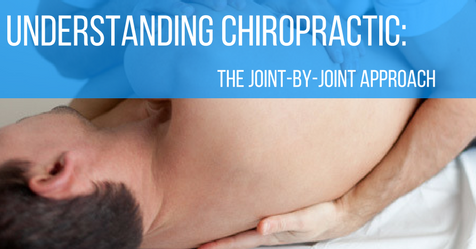Understanding Chiropractic: The Joint-by-Joint Approach
As stated in previous blogs, defining and understanding chiropractic can be vague. There are many techniques offered by chiropractors in an attempt to address a variety of health issues - not always musculoskeletal in nature. However, when considering chiropractic, most individuals think of some form of manipulation or adjusting. To better understand how chiropractic adjustments are beneficial, a concept known as the "Joint-by-Joint Approach," established by Mike Boyle and Gray Cook, needs to be acknowledged.
The joint-by-joint approach highlights different joints of the body that should focus more around stability or mobility in relation to the joint(s) above and below. It is a look at the body purely in regards to mechanical motion. For instance, the foot should be more stabile and the ankle more mobile. If this were flip-flopped, then walking would be visually much more interesting. Stating this, everyone is different, with their own specific needs; some individuals are too stiff in their feet and need increased mobility (whereas others may have weak ankles that need to be stabilized). The joint-by-joint concept is merely a way to appreciate the general mechanics of the body, during specific tasks.
Understanding the Joint-by-Joint Approach
The body is relatively a closed system. To accomplish any form of movement the body must create and maintain certain internal forces to achieve a task, such as picking up a cell phone off the ground. The brain tells the body to do something while generating the needed internal forces, through muscular activation, to achieve that task. The joint-by-joint approach is a way to identify the general movement capability of these internal forces, to complete that task.
When there is lack of motion in a region of the body, it forces the areas above or below to compensate by increasing their respective joint ranges. An example can be picking up a cellphone off of the ground: if the hips are tight and cannot fully express their needed range of motion, then the low back or knees have to compensate in order to allow the body to pick up the cellphone. Overtime, this can lead to pain in the low back, hips, knees or along associated myofascial or neurogenic referral patterns.
Integrating Chiropractic into the Joint-by-Joint Approach
For the previous example, chiropractic adjustments can help restore the needed range of motion in the hips. Inadequate hip range of motion often requires the lower back to increase its range of motion, to help with the numerous tasks performed throughout the day. Improving the quality of motion in the hips helps to reduce the strain, within the low back, by sharing the workload more evenly between these two regions of the body.
This concept can be applied to all joints within the body. When combining concepts, established across multiple disciplines – i.e. chiropractic and joint-by-joint approach – better understanding and outcomes will be achieved. Understanding that the chiropractic adjustment has a vital place within healthcare, along with the integration of various other healthcare model, will ultimately improve the quality of care provided by our health system. Integrating multiple disciplines into one cohesive model into a single visit will also help reduce the overwhelming cost and burden our healthcare system has become to society.
About the author
Dr. Keith Sparks is an award-winning chiropractor, functional medicine expert, and the co-founder of ICT Muscle & Joint Clinic. Dr. Sparks’ emphasis of care originated within the fields of rehabilitation, soft-tissue therapies, and chiropractic. To date, he has brought this unique combination of skills into union with functional medicine. The sole purpose of intertwining these distinct skills, knowledge, and services is to provide incomparable care to his local community. Dr. Keith Sparks is often seen in the Wichita, KS community speaking at business events and teaching health and performance classes.
